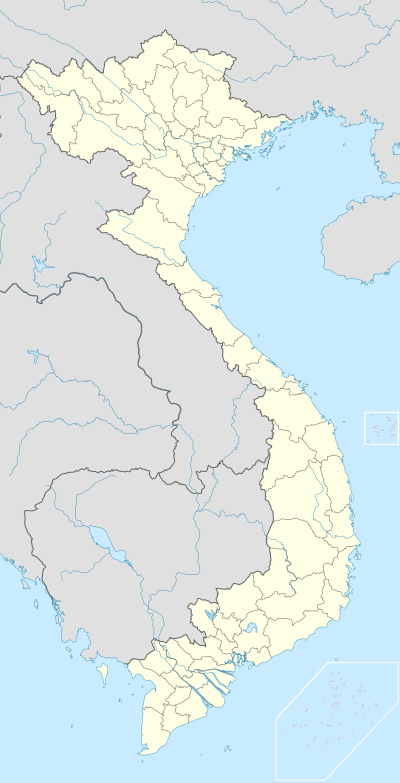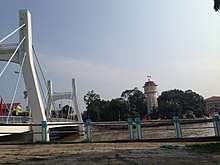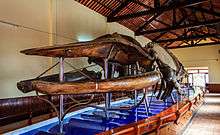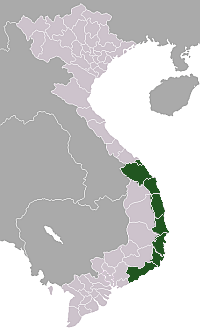Phan Thiết
Phan Thiết (Vietnamese: [fan.tʰíət] (![]()
Phan Thiết Thành phố Phan Thiết | |
|---|---|
| Phan Thiết City | |
 "Phan Thiết Water Tower": symbol of Phan Thiết | |
 Phan Thiết | |
| Coordinates: 10°56′N 108°06′E | |
| Country | |
| Province | Bình Thuận |
| Founded | 1898, as Phan Thiết town, by Thành Thái |
| Incorporated | 1933, as the Commune of Phan Thiết |
| Consolidated | 1999, as the City of Phan Thiết |
| Named for | Hamu Lithit (Cham language) |
| Area | |
| • City (Class-2) | 206 km2 (80 sq mi) |
| Population (2015) | |
| • City (Class-2) | 335,212 |
| • Density | 1,627/km2 (4,210/sq mi) |
| • Urban | 299,680 |
| Time zone | UTC+07:00 (IST) |
| ZIP codes | 80xxxx[1] |
| Area code(s) | 62 |
| Climate | Aw |
Traditionally, fishing and manufacturing of fish sauce has been the main source of Phan Thiết's income thus far, the picturesque fishing fleet in the harbor providing colorful proof. Drawn by the beautiful beaches of the area, tourism is rapidly replacing the fishing industry as the main employer.
The first resorts along the beaches of Hưng Long and Phú Thủy wards, as well as Phú Hài and Hàm Tiến wards east of the city center appeared in the mid-nineties. Since then, tourism has boomed and hundreds of hotels, restaurants, resorts, guesthouses and shops have been constructed along the coastline.
Rang Beach in Hàm Tiến ward was discovered by foreigners in 1995 while they watched the solar eclipse. Misled by guidebooks, which incorrectly labelled Rang Beach as "Mũi Né Beach", they were the first of a long row of tourists mistakenly calling everything east of the Phan Thiết city center "Mũi Né."[2]
Each area of Phan Thiết has its own characteristics. The beaches of Kê Gà and Tiến Thành are peaceful and quiet, inviting tourists to swim and relax. There is not much traffic on the roads along the coastline, so walking or riding along the beach is quite peaceful.
Compared to Nha Trang, the density of resorts along the beaches of the city center in Phan Thiết is quite low, so when tourists leave their hotels, they step into the middle of the bustling daily life of a Vietnamese city. You can walk to many restaurants, museums or shopping malls – even visit the school where Hồ Chí Minh taught before he went to study in Paris.
Phú Hài ward covers a hilly area along the coastline and has many small beaches and hidden coves. Many of the resorts in this ward are built above the water on the hills and have a relatively small beach to themselves. Sea Links City, composed of a hotel, condos, apartments, a winery and a golf course, is located here. Ba Nai Hill in Phú Hài ward is the place of the old Po Sah Inư Cham Tower, built in the 8th century and worth a visit.
Alongside the 10 kilometer strip of what is locally known as Rang Beach, in Hàm Tiến ward, there is a lively tourist strip. Hundreds of resorts, hotels, bars, restaurants, shops, travel agencies and spas are situated here.
In recent years advanced beach erosion has become a major issue for Phan Thiết's beaches, especially in Phú Hài and Hàm Tiến wards, so some resorts lack a beach at high tide: the water directly reaches the sea wall. In recent years a number of resorts had to install geotechnical tubes (Geotubes) to keep their beaches from further eroding.
One of the great tourist attractions of Hàm Tiến is the so-called Fairy Stream, where a small creek has carved a canyon through the dunes, revealing colorful layers of sand and limestone.
Beyond Hàm Tiến is Mũi Né, consisting of two communities, adding up to around 25,000 residents in the actual town, and two beaches. The second community is Hon Rom, a fishing village with a few hundred residents. Mũi Né has the highest population outside the city center and is quite lively in the morning. In the evening locals join together for coffee or dinner at the many cafés and restaurants, especially around the local market.
Mũi Né actually translates to "Shelter Cape," because for ages the local fishermen used the cape to shelter their boats from the wind.[2] The town itself covers the west side of the cape, whereas many resorts are alongside Ganh Beach and Suối Nước. A resort in Mũi Né ward is the right decision for people who want to be close to a local community, but keep their distance from the bustling tourist strip and rather prefer a quiet beach.
Another tourist attraction are the orange sand dunes, located on a hill between Mũi Né and Hon Rom. At the entrance of Hon Rom you can explore the "Red Canyon", a small cliff which has eroded to create a beautiful ridge, consisting of fragile red sand. The larger white sand dunes (Bàu Trắng) are around 23 kilometers north of the town.
Phan Thiết operators usually make a distinction between the winter and summer seasons. During winter, mostly Northern Europeans and Russians spend their holidays here, far away from the northern chill, to enjoy kitesurfing and windsurfing. In the summer season, Phan Thiết is a popular destination for Australians and North Americans, as well as many Vietnamese escaping the steaming hot cities for a fresh breeze of sea wind.
Name
There are several theories about the origin of the name Phan Thiết, most of which agree that it is not a pure Vietnamese name:
- Before the Vietnamese conquest of the area in the 17th century, the Cham people called this land "Hamu Lithit" – with "Hamu" meaning hamlet in the field, and "Lithit" meaning near the sea. With the arrival of Vietnamese settlers, a new name in Vietnamese was gradually developed. Since the Vietnamese had already changed the Cham city of Panduraga into Phan Rang and another settlement into Phan Rí, they attached the prefix "Phan" into the shortening of "Lithit" to make the name Phan Thiết.
- Vietnamese people have been transliterating the Cham names into more Vietnamese sounding names: Panduranga or Mang-lang into Phan Rang, Mang-lý into Phan Rí, Hamu Lithit or Mang-thit into Phan Thiết. Those three places are referred to as "Tam Phan" (Triple Phan).
- The name of the Cham Prince who was the military governor of the area in the 15th century was Po Thit (brother of the princess Po Sah Inư and son of King Par Ra Chăm Chanh or Trà Chanh). The fortification was thus called Camp Po Thit. The Vietnamese pronounced the camp name as "Phan Thiết."
History
- This area used to belong to the ancient kingdom of Champa and was later absorbed into the Đại Việt Empire (former name of Vietnam). Vietnamese rule was established over the area which has become the present-day province of Bình Thuận, although back then the administrative level and the boundaries of the area hadn't been determined.
- In 1697, Bình Thuận in turn was changed from a fort ("trấn") to a district (phủ), then to a dinh. Later, Phan Thiết was officially recognized as a đạo (along with Phan Rang, Phố Hài and Ma Ly of the Tam Tân area).
- From 1773 to 1801, there was fierce fighting between the forces of the Nguyễn dynasty and Tây Sơn dynasty in the area.
- In 1825, during the reign of Emperor Minh Mạng, Bình Thuận officially became a province; part of Phan Thiết was made into the district of Hàm Thuận. In 1854, during Tự Đức's reign, the district was renamed Tuy Lý.
- In 1836 (the 17th year of Minh Mạng's reign), a cabinet officer named Đào Tri Phủ was sent to Bình Thuận to oversee the surveying tasks and establish land boundaries for 307 communes and villages in fifteen districts of Bình Thuận in order to determine taxation. On the right bank of the river (Cà Ty river today) were Đức Thắng, Nhuận Đức and Lạc Đạo village. On the left bank were Long Bình and Minh Long.
- Even near the end of the 19th century, Phan Thiết was not yet officially recognized as an administrative unit (lower level) within Bình Thuận province.
- In 1898 (the 10th year of the reign of Emperor Thành Thái), Bình Thuận's provincial capital was moved to Phú Tài village, a suburb of Phan Thiết. On 20 October of that year, Thành Thái signed a decree to make Phan Thiết a city and provincial capital (on the same day as the establishment of the cities of Bình Thuận, Huế, Hội An, Qui Nhơn, Thanh Hóa and Vinh).
- In the 20th century, it was a center of the VNQDĐ independence movement.[3]
Climate
| Climate data for Phan Thiết | |||||||||||||
|---|---|---|---|---|---|---|---|---|---|---|---|---|---|
| Month | Jan | Feb | Mar | Apr | May | Jun | Jul | Aug | Sep | Oct | Nov | Dec | Year |
| Record high °C (°F) | 35.4 (95.7) |
34.0 (93.2) |
35.8 (96.4) |
37.2 (99.0) |
37.7 (99.9) |
37.6 (99.7) |
35.9 (96.6) |
36.0 (96.8) |
36.1 (97.0) |
34.7 (94.5) |
34.5 (94.1) |
34.5 (94.1) |
37.7 (99.9) |
| Average high °C (°F) | 29.2 (84.6) |
29.4 (84.9) |
30.5 (86.9) |
31.9 (89.4) |
32.6 (90.7) |
32.1 (89.8) |
31.5 (88.7) |
31.4 (88.5) |
31.1 (88.0) |
30.9 (87.6) |
30.7 (87.3) |
29.8 (85.6) |
30.9 (87.6) |
| Daily mean °C (°F) | 24.8 (76.6) |
25.4 (77.7) |
26.6 (79.9) |
28.1 (82.6) |
28.6 (83.5) |
27.8 (82.0) |
27.1 (80.8) |
27.0 (80.6) |
27.0 (80.6) |
26.9 (80.4) |
26.4 (79.5) |
25.5 (77.9) |
26.8 (80.2) |
| Average low °C (°F) | 21.2 (70.2) |
22.0 (71.6) |
23.6 (74.5) |
25.3 (77.5) |
25.7 (78.3) |
25.1 (77.2) |
24.7 (76.5) |
24.7 (76.5) |
24.5 (76.1) |
24.2 (75.6) |
23.3 (73.9) |
21.9 (71.4) |
23.9 (75.0) |
| Record low °C (°F) | 14.2 (57.6) |
16.3 (61.3) |
17.2 (63.0) |
19.9 (67.8) |
22.0 (71.6) |
21.7 (71.1) |
20.8 (69.4) |
20.6 (69.1) |
21.7 (71.1) |
20.3 (68.5) |
18.1 (64.6) |
12.4 (54.3) |
12.4 (54.3) |
| Average precipitation mm (inches) | 1 (0.0) |
0 (0) |
6 (0.2) |
30 (1.2) |
136 (5.4) |
145 (5.7) |
165 (6.5) |
164 (6.5) |
192 (7.6) |
155 (6.1) |
58 (2.3) |
20 (0.8) |
1,072 (42.2) |
| Average precipitation days | 0.4 | 0.4 | 0.7 | 3.5 | 12.7 | 16.4 | 16.3 | 18.4 | 17.2 | 13.5 | 7.0 | 3.1 | 109.6 |
| Average relative humidity (%) | 74.3 | 74.7 | 76.3 | 77.8 | 79.8 | 81.7 | 83.2 | 83.4 | 84.4 | 83.3 | 79.5 | 76.4 | 79.6 |
| Mean monthly sunshine hours | 278 | 272 | 304 | 282 | 247 | 215 | 214 | 203 | 197 | 211 | 217 | 240 | 2,880 |
| Source: Vietnam Institute for Building Science and Technology[4] | |||||||||||||
Administrative divisions
Phan Thiết is subdivided into 18 wards and communes, of which 14 are urban wards, namely: Đức Thắng, Đức Nghĩa, Đức Long, Phú Hài, Phú Thủy, Phú Trinh, Phú Tài, Thanh Hải, Hàm Tiến, Mũi Né, Xuân An, Bình Hưng, Hưng Long and Lạc Đạo, and 4 suburban communes, namely: Tiến Lợi, Tiến Thành, Thiện Nghiệp and Phong Nẫm.

Located on an arm of the East Vietnam Sea, Phan Thiết is one of Vietnam's most important fishing areas. Its population is roughly 205,333 (as of 2004). Hồ Chí Minh reportedly lived in Phan Thiết for a short time around 1910 and worked as a schoolteacher.
During the Vietnam War, Phan Thiết was the site of the U.S. military base known as Landing Zone Betty, which was located at the now closed airfield southwest of the city. In recent years, Phan Thiết (specifically Mũi Né Beach) has been transformed into a resort destination. 24 October 1995 is considered to be the birth of tourism in Phan Thiết, when thousands rushed to Mũi Né to see the total solar eclipse. The event was commemorated on the same day in 2005 as the tenth anniversary of tourism for the province. Local people in Phan Thiết regularly practice a ceremony to a whale god, which is believed to give good luck in nautical pursuits.[5]

Photos of Phan Thiết
- Bridge in Phan Thiết
- Hotel in Phan Thiết
- Statue in Phan Thiết
- Street in Phan Thiết
- Street in Phan Thiết
- Beach in Phan Thiết
 Vạn Thủy Tú temple, one of the Vietnamese Whale worship sites, hosts the largest whale skeleton in Vietnam.
Vạn Thủy Tú temple, one of the Vietnamese Whale worship sites, hosts the largest whale skeleton in Vietnam.
References
- http://postcode.vnpost.vn/
- City Pass Guide: Phan Thiet
- Van Dao Hoang Việt Nam Quốc Dân Đảng: A Contemporary History of a National ... 2008 Page 158 "Phạm Hoài Xuân's ancestors originated from Phan Thiết. He was now to continue his revolutionary works with the other members of the VNQDĐ in Phan Thiết."
- "Vietnam Building Code Natural Physical & Climatic Data for Construction" (PDF) (in Vietnamese). Vietnam Institute for Building Science and Technology. Archived from the original (PDF) on 22 July 2018. Retrieved 23 July 2018.
- The whale god of Phan Thiết
External links
| Wikimedia Commons has media related to Phan Thiet. |
